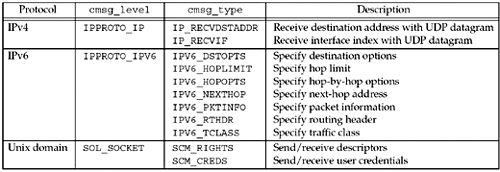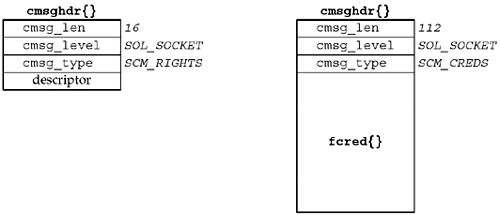14.6 Ancillary Data
Ancillary data can be sent and received using
the msg_control and msg_controllen members of the
msghdr structure with the sendmsg and
recvmsg functions. Another term for ancillary data is
control information. In this
section, we will describe the concept and show the structure and
macros used to build and process ancillary data, but we will save
the code examples for later chapters that describe the actual uses
of ancillary data.
Figure
14.11 is a summary of the various uses of ancillary data we
cover in this text.

The OSI protocol suite also uses ancillary data
for various purposes we do not discuss in this text.
Ancillary data consists of one or more
ancillary data objects, each one
beginning with a cmsghdr structure, defined by including
<sys/socket.h>.
struct cmsghdr {
socklen_t cmsg_len; /* length in bytes, including this structure */
int cmsg_level; /* originating protocol */
int cmsg_type; /* protocol-specific type */
/* followed by unsigned char cmsg_data[] */
};
We have already seen this structure in Figure
14.9, when it was used with the IP_RECVDSTADDR socket
option to return the destination IP address of a received UDP
datagram. The ancillary data pointed to by msg_control
must be suitably aligned for a cmsghdr structure. We will
show one way to do this in Figure 15.11.
Figure
14.12 shows an example of two ancillary data objects in the
control buffer. msg_control points to the first ancillary
data object, and the total length of the ancillary data is
specified by msg_controllen. Each object is preceded by a
cmsghdr structure that describes the object. There can be
padding between the cmsg_type member and the actual data,
and there can also be padding at the end of the data, before the
next ancillary data object. The five CMSG_xxx macros we describe shortly account for
this possible padding.

Not all implementations support multiple
ancillary data objects in the control buffer.
Figure
14.13 shows the format of the cmsghdr structure when
used with a Unix domain socket for descriptor passing (Section
15.7) or credential passing (Section 15.8).

In this figure, we assume each of the three
members of the cmsghdr structure occupies four bytes and
there is no padding between the cmsghdr structure and the
actual data. When descriptors are passed, the contents of the
cmsg_data array are the actual descriptor values. In this
figure, we show only one descriptor being passed, but in general,
more than one can be passed (in which case, the cmsg_len
value will be 12 plus 4 times the number of descriptors, assuming
each descriptor occupies 4 bytes).
Since the ancillary data returned by
recvmsg can contain any number of ancillary data objects,
and to hide the possible padding from the application, the
following five macros are defined by including the
<sys/socket.h> header to simplify the processing of
the ancillary data:
|
#include <sys/socket.h>
|
|
#include <sys/param.h> /* for ALIGN
macro on many implementations */
|
|
struct cmsghdr *CMSG_FIRSTHDR(struct msghdr
*mhdrptr) ;
|
|
Returns: pointer to first cmsghdr
structure or NULL if no ancillary data
|
|
struct cmsghdr *CMSG_NXTHDR(struct msghdr
*mhdrptr, struct cmsghdr
*cmsgptr) ;
|
|
Returns: pointer to next cmsghdr
structure or NULL if no more ancillary data objects
|
|
unsigned char *CMSG_DATA(struct cmsghdr
*cmsgptr) ;
|
|
Returns: pointer to first byte of data
associated with cmsghdr structure
|
|
unsigned int CMSG_LEN(unsigned int
length) ;
|
|
Returns: value to store in cmsg_len
given the amount of data
|
|
unsigned int CMSG_SPACE(unsigned int
length) ;
|
|
Returns: total size of an ancillary data object
given the amount of data
|
POSIX defines the first three macros; RFC 3542
[Stevens et al. 2003] defines the last two.
These macros would be used in the following
pseudocode:
struct msghdr msg;
struct cmsghdr *cmsgptr;
/* fill in msg structure */
/* call recvmsg() */
for (cmsgptr = CMSG_FIRSTHDR(&msg); cmsgptr != NULL;
cmsgptr = CMSG_NXTHDR(&msg, cmsgptr)) {
if (cmsgptr->cmsg_level == ... &&
cmsgptr->cmsg_type == ... ) {
u_char *ptr;
ptr = CMSG_DATA(cmsgptr);
/* process data pointed to by ptr */
}
}
CMSG_FIRSTHDR returns a pointer to the
first ancillary data object, or a null pointer if there is no
ancillary data in the msghdr structure (either
msg_control is a null pointer or cmsg_len is less
than the size of a cmsghdr structure).
CMSG_NXTHDR returns a null pointer when there is not
another ancillary data object in the control buffer.
Many existing implementations of
CMSG_FIRSTHDR never look at msg_controllen and
just return the value of cmsg_control. In Figure
22.2, we will test the value of msg_controllen before
calling this macro.
The difference between CMSG_LEN and
CMSG_SPACE is that the former does not account for any
padding following the data portion of the ancillary data object and
is therefore the value to store in cmsg_len, while the
latter accounts for the padding at the end and is therefore the
value to use if dynamically allocating space for the ancillary data
object.
|